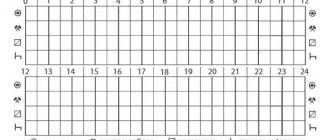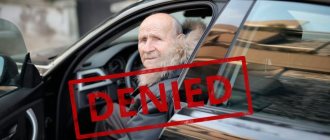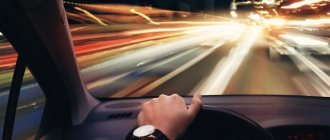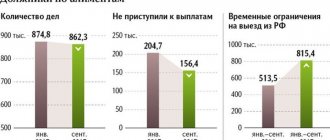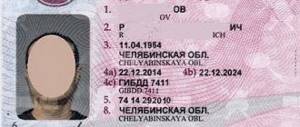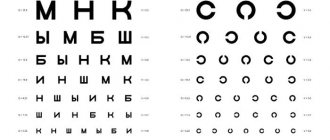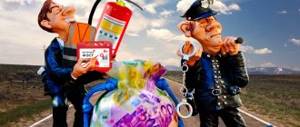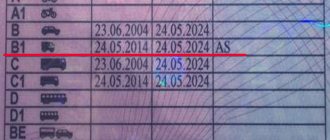If a person has vision problems, then he is required to drive a car only with glasses or contact lenses. This is a guarantee of his safety and the safety of other road users. A special note is made about this fact on the driver’s license. The document states that glasses are required for the driver. If the subject violates these rules and neglects safety, then he must pay a monetary penalty. And further about what its size is and what responsibility is for such actions.
Marking points on your license: what is it and what does it oblige you to?
Current legislation does not in any way restrict drivers who even have health problems. In order not to infringe on the rights of people with poor vision, the ability of such subjects to drive a vehicle is provided. Logically, if they can perform other types of work wearing glasses or lenses, then why can’t they drive?
But the presence of vision problems obliges the subject to drive with special equipment - glasses or contacts.
And there is even a special note about this on the driver’s license. The note may have the following wording: “Glasses/lenses are required.” This means that the driver has a medical obligation to wear glasses or contact lenses while driving a vehicle. If he does not want or cannot for some reason put on glasses, then he cannot sit behind the wheel. It's simple. Interesting information : such a note as “Glasses-lenses are required” exists on driver’s licenses that were issued before 2011. Consequently, the maximum period for their circulation is until 2021. We remember that the document has a validity period of 10 years. After this period it must be replaced.
Requirements for the visual organ to obtain rights
What kind of vision you can drive with is stipulated in the legislation, but the decision on admission is made by the ophthalmologist during the examination process. It is he who records the indicators and writes them down in the medical report. It must be obtained before applying for training at a driving school. Without a medical examination, it is impossible to pass all the tests and take the exam at the State Traffic Safety Inspectorate. Therefore, a citizen will know about his suitability in advance. Today the following vision restrictions have been established for drivers of category “B”:
- The acuity of one eye is min 0.6 units.
- Coefficient of the second min 0.2 units.
For category “C”, higher requirements are provided: one of the eyes must see min 0.8 units, the second is subject to a condition of 0.4 units. When the examination parameters are within the established limits, the person receives admission. In other situations, driving will be prohibited.
It is important to know! There are often drivers wearing glasses on the roads, so you should not regard reduced vision as a direct contraindication to driving a car.
But it is extremely important to inform your ophthalmologist about them; you should and definitely take them with you to the consultation. Then the check is carried out taking into account the use of corrective means that improve visibility. If a person receives permission to drive a car, then this will only have to be done with glasses or lenses, about which a special note will be made in the conclusion.
About (GCL)
Regarding the new rights that are issued according to international standards, they have a completely different mark. At the same time, the meaning of this mark is similar. But it is called “GCL”. This abbreviation literally stands for glasses or contact lenses. From English this translates as glasses or contact lenses. This mark also indicates that the subject has some visual impairment and should operate the vehicle with glasses or contacts only.
Both marks are similar in essence and can be used in both national and international licenses.
What marks are set on the licenses of drivers with visual impairments?
The traffic police inspector may find out that the driver is required to have glasses or lenses when checking documents. A note indicating the need for vision correction is on the driver's license. However, it may differ depending on the type of ID. Old-style documents are marked “Glasses/lenses are required.” And in plastic national licenses the abbreviated mark GCL is put.
“Glasses/lenses are required”
This mark was on old-style certificates that were issued before 2011. Their validity period is 10 years, so by 2021 there will be no such certificates left. However, at the moment there are still drivers with paper licenses. It is located on the first page in the “Special notes” column.
GCL - what is it?
In plastic documents of the new sample, another entry may be placed - GCL. This abbreviation reads “Glasses or Contact Lenses”. The mark is located on the back of the plastic card in column 14 - under the table.
Note: where should it be?
Proper and correct indication of visual limitations is Section 14 of a driver’s license. This is not any other section, incl. and not section 12, as most people think. For example, section 12 indicates health restrictions of a more global nature.
But this concerns new rights. The old rights do not have such sections. In this case, the note is indicated where space is provided for special notes. This can be either on the front of the license or on the back of the document.
There are no glasses or lenses, but there is a note on the license: what is the fine?
An interesting situation with the responsibility of drivers who are required to drive a car with glasses or lenses. If you look at the Administrative Code, there are no types of liability for such actions. Theoretically, the subject could operate the car without glasses and suffer no consequences. But the practice of 2021 shows that fines are still applied. And the amount of the penalty is not small. It can even reach 15,000 rubles. The minimum penalty is 5,000 rubles.
And such situations are quite controversial. In fact, inspectors apply rules that indicate a ban on driving a vehicle at all. But it is not so. And this is also proven by judicial practice, when judges’ decisions are made in favor of violators.
But there are other court verdicts that indicate the following: if there is a note on the license, then the driver is required to wear glasses or contacts. If they are not there, then such control of the vehicle is equivalent to driving without a license. And here there is a legislative basis for such a norm.
According to the law, a driver cannot drive a car in three cases:
- the subject's rights were confiscated;
- the driver's license has expired;
- There are medical contraindications/restrictions.
And the third option is precisely related to the GCL mark. But here we also need to make a distinction:
- medical contraindications – if present, the subject is generally prohibited from driving the vehicle;
- medical restrictions are the inability to drive specific types of vehicles or drive any type of car under specific conditions.
So, visual impairment is equated precisely to medical contraindications. And therefore it is punishable by a fine. Although in fact, poor vision is not always a contraindication. The issue is ambiguous and remains at the discretion of the judges. But if you appeal with the same Code of Administrative Offenses, then the amount of the penalty should be 500 rubles, but not 15,000.
Why are glasses dangerous while driving?
Any airbag in a car can become like a loaded gun if it is not handled correctly.
This is why there is a ban on placing navigators and tablets on plastic mounts, metal icons, massive amplifiers for a multimedia system and other objects on the steering wheel that can cause injury when the airbag squib is deployed.
Even glasses, which are one of the most common items among drivers, can become dangerous. What injuries can be caused to a person wearing glasses when their face hits an inflated airbag?
Unbuckled seat belt. The level of danger will primarily depend on the shape of the glasses, their size and material of manufacture. Often, when producing glasses, lenses made of thick glass are used, often insufficiently secured, which leads to a real risk for the driver. From a blow, this type of glasses can break, fly out with one of the edges in the direction transverse to the frame, and become a sharp knife aimed directly at the eyeball. The final consequences are difficult to predict.
The greatest danger also arises when a driver gets into an emergency without wearing a seat belt. In this case, when making a head-on collision with an obstacle, he will definitely lean forward and expose his head to the impact of the expanding airbag. In this position, glasses can fly off and cause maximum damage.
The frame has fallen off. If the driver does fasten his seat belt, then the possibility of injury becomes much lower, although it still cannot be completely avoided. At the moment of impact, the belt will restrain the forward movement of the body and ensure that it is directed towards the pillow. In this case, the glasses usually fly off even before the airbag is deployed, and fly towards the windshield. This means that they are absent from the face at the moment of contact with the pillow, as they fly away behind the steering column and ricochet off the windshield and fall to the floor.
However, if a driver uses glasses that have curved temples or are equipped with devices to hold them in place, injury will be inevitable. Held by temples or chain, the glasses remain on the face or neck. The consequences are a broken frame, glass positioning in a perpendicular direction and wounds to the driver’s face.
Safe types of glasses. The only way to prevent injury is to use glasses with safe plastic frames while driving, which do not break, but only bend under increased load. Glass frames can also be made of plastic, a feature of which is the presence of a special coating layer, the purpose of which is to protect the eyes from the harmful effects of ultraviolet rays.
The same points apply to those drivers who like to drive with glasses to protect them from the sun's rays. Their plastic glasses must ensure the prevention of injury, eliminating cracking and breaking upon impact. In addition, they must be firmly fixed on the driver’s head.
Color. The color in which the glasses themselves are painted is also of considerable importance. The fact is that colors have a psychophysical effect on the driver’s state, which will indirectly affect how he behaves on the road. For example, “chameleon” type lenses tire your eyesight quite a lot due to the presence of areas on the glass with uneven color distribution. Yellow color reduces the degree of concentration.
Bottom line. If it is necessary to wear glasses while driving, the driver should take the maximum degree of safety in case of an emergency.
The fact of presence of lenses: is it worth proving to the inspector or not?
Let's say there is a note on your driver's license that you need to use glasses or contacts. No one has the right to force a person to use a specific frame; he can easily use lenses. And here you need to understand: if an inspector stops a subject with lenses, then he cannot predict in any way that he has a special mark on his license. The lenses are not visually detected.
Secondly, it is necessary to justify the very fact of the stop; for this there must be other violations. If they are not there and the driver asks the person to present a license that has a mark on it, and then begins to determine the presence of lenses, then this is a rather subjective attitude.
And most importantly: the inspector is obliged to prove the guilt of the subject before drawing up a protocol on administrative punishment. That is, he must present facts indicating the absence of lenses. It is impossible to do this. And ideally, a penalty cannot be issued for such a violation. In fact, first protocols are drawn up and penalties are issued, and then decisions are appealed in court.
Penalty for driving without glasses
If, based on the results of a medical examination, the driver is prescribed the mandatory use of honey. products for vision correction, then this information is entered into the driver’s license (hereinafter referred to as the driver’s license). In the old-style VU, “special marks” are on the front side of the document, and in the new one, on the back under paragraph 14.
The GCL (Glasses or Contact Lenses) mark on the new driver's license also indicates that the driver is required to use medical devices for vision correction. If your driver's license has this mark, then you have the right to drive a vehicle with both lenses and glasses.
At the same time, if the traffic police officer does not have any difficulties in determining whether you are wearing glasses or not, then it is almost impossible to identify the presence of lenses without removing them. No one will demand that you remove and show your lenses, and the inspector will have to take your word for it.
Restoration of driver's license (read more...)
In 2008, he was deprived of his driver's license for 1.5 years. He left for permanent residence in another city. In 2012, I came to pick up my license with all the required documents. The State Traffic Safety Inspectorate reported that the rights were accidentally destroyed, and the restoration of rights was denied due to a change in registration of permanent residence. Tell me what to do in such a situation, how to restore rights.
I have a residence permit in St. Petersburg, temporary registration in Chelyabinsk, I am in Chelyabinsk, after losing my license to restore them, I need a certificate from St. Petersburg stating that I have not lost my driver’s license, can my relatives get this certificate in St. Petersburg instead of me and where should they go? and what documents should I have with me? Thank you.
Driver's license restoration
You will need the following documents: Driver's license Passport or other identification document Document confirming registration at the place of residence or stay Medical certificate of the established form Document confirming payment of the appropriate state fee
A citizen of Ukraine on the territory of Russia has been deprived of his license for driving while intoxicated: a 30 thousand fine (paid), a year and a half of deprivation of rights has practically passed. What punishment should you have if you don’t pass the traffic rules, don’t take away your seized license, and drive on a driver’s license restored in Ukraine? Is there any statute of limitations?
How is it possible to prove the presence of lenses?
If you are stopped by an inspector and you are required to wear glasses or contacts, then you can simply say that you are now wearing contacts. There is not a single norm that would oblige a subject to wear only glasses.
Another thing is that the inspector may not believe it. But this is not enough for administrative responsibility. First you need to undergo a medical examination and receive the results of the examination. To do this, the traffic police officer must offer you to undergo such an analysis. And when there is a result, make a decision on punishment (if necessary).
Appealing an issued monetary penalty
Everyone has the right to appeal. But here we need to evaluate the real facts. If you are required to drive with glasses or contacts, but for some reason you did not do this, which is confirmed by a medical examination, then filing a complaint is pointless. The court's decision will be made similar to the inspector's decision.
If you did not violate, but objectively were wearing lenses, then the statement of claim makes sense. As a rule, if there is no medical examination, but only an inspector’s report, the court goes to the meeting of the driver. It wouldn’t hurt to record a conversation with a traffic police officer on camera.
How to take a photo with your license - with or without glasses
In 2021, you can take a photo of your license wearing glasses, but under one condition - when the doctor prescribed them. If you wear glasses all the time, then you can take pictures with them on, but only on the condition that they do not block most of your face . It is not recommended to be photographed wearing glasses with thick frames. Glasses must not be tinted. If you wear lenses, you should make sure that there is no glare in the photo in the eye area. In any case, you have the right to either remove them for photography or leave them. The only requirement is that the glasses do not block most of the face and that they are not darkened . If you take a photo for your license without glasses, but you constantly wear them in everyday life, then there should be a footnote at the bottom: “glasses or contacts are required.”
If you took a photo with glasses, but your vision was restored after correction, then this record will remain until the next replacement of your driver's license. If they stop you and ask, after checking your documents, why you are without glasses, you can always answer that you have switched to contact lenses. And this is quite difficult to verify.
According to Appendix No. 3 Read the contents of the Order on the legal portal www.consultant.ru Order of the Ministry of Internal Affairs of the Russian Federation No. 355, drivers even have the right to be photographed wearing a headdress , if it does not cover most of the face. This right applies to people whose religious beliefs do not allow them to wear hats.
Appendix No. 3 of Order of the Ministry of Internal Affairs of the Russian Federation No. 355:
Appendix No. 3
(as amended on October 20, 2015)
A driver's license (hereinafter referred to as the license) is issued using automated workstations.
The numbering of the sections of the ID is printed in lilac, the rest of the entered information, including the table of categories and subcategories on the reverse side, is printed in black. (Paragraph as amended, put into effect on April 1, 2014 Read the contents of the Order on the legal portal www.consultant.ru Order of the Ministry of Internal Affairs of Russia dated January 9, 2014 No. 6.
A color photograph of the holder is taken digitally during the ID issuance process on a gray background and printed in a specially designated area on the ID.
The photograph must have a clear image of the face strictly from the front without headdress. It is allowed to take photographs in hats that do not hide the oval of the face for citizens whose religious beliefs do not allow them to appear in front of strangers without hats. For citizens who constantly wear glasses, photography is allowed with glasses without tinted lenses.
All entries in the driver’s license are made in Russian and are duplicated using the transliteration method (simply replacing Russian letters with Latin ones), taking into account the international one recommended by ICAO.
The completed certificate is folded along the fold line, placed in a lamination bag consisting of three layers: a top and bottom transparent laminate, as well as a middle layer of opaque material placed inside the certificate, and then laminated and cut out in the prescribed format.
Keep in mind that getting a driver's license is the same as getting a passport. After all, your license can be used as an identity document. Therefore, the person in the photo should be clearly visible. Otherwise, they will simply be considered invalid.
If you have been driving for many years, but for some reason you need to renew your license, for example, you lost it or it got damaged, then you will be given a new version of the license. According to the Order of the Ministry of Internal Affairs No. 390, Appendix 1, read the contents of the Order on the legal portal www.consultant.ru, the new driver’s license fully complies with the most stringent requirements of the international convention on road traffic, to which our country has also joined.
In the new model license, in addition to categories A, B, C, D and E, there are categories BE, CE and DE . These new rights are valid in the same way as the old ones - for 10 years. But drivers have the right not to exchange old driving licenses for new ones until their validity period expires. Although, at your personal request, you can exchange documents for new ones at any traffic police department.
A new international certificate is created within a few minutes thanks to modern innovative technologies. The new driver's license is the size of a bank card. Their appearance is now more attractive.
Although the rules for issuing new driver's licenses have changed, the photo requirements have not changed at all. An exception is that such photographs are now mainly taken at the traffic police department, since they have special optical-electronic equipment that makes it possible to take an instant photo in accordance with all requirements and standards.
In addition, photographs are now applied to a plastic ID using special computer equipment. This process is fully automated. If you take a photo at the traffic police station, then all responsibility for compliance with the norms and standards of rights will also fall on the shoulders of the police officers.
What about medical vision limitations in 2021?
Everything is clear here. There is an adopted Government Resolution No. 1604, which sets the limits of vision:
- In the worst visible eye, vision should be at least 0.2;
- On the best eye - not lower than 0.6.
The norm is fulfilled for both eyes at once. If at least one condition is not met, therefore, the subject cannot control the vehicle.
It is impossible to determine the quality of vision simply at the discretion of the inspector. Therefore, he cannot issue a fine either if there is a mark on the license or if it is absent. Even if he thinks that the driver sees very poorly. Only a medical examination allows you to obtain a reliable result. Until then, they have no right to issue a fine.
For category A
— Visual acuity is below 0.6 and 0.2 in one and the other eye with correction. Correction of myopia and farsightedness of 8.0D, including correction with contact lenses, as well as astigmatism of 3.0D (the total value of the sphere and cylinder must be below 8.0D) is considered acceptable. The difference in the optical power of the lenses of both eyes is up to 3.0D.
— Lack of vision in one eye with vision up to 0.8 in the other (without correction).
- Central scotoma, absolute or relative (for scotoma with changes in visual functions above the values of the first point - admission without restrictions).
— Acceptable correction of myopia and farsightedness up to 8.0D, including correction with contact lenses, as well as astigmatism – 3.0D (the total power of the sphere and cylinder must be less than 8.0D). The difference in the optical power of the lenses of both eyes should be up to 3.0D, without complications, with the initial refraction - from +8.0D to -8.0D. If it is impossible to establish the initial refraction (due to surgery), the issue of professional suitability is resolved positively if the length of the eye axis is 21.5 - 27.0 mm.
— Artificial lens, even on one of the eyes. Only experienced drivers with visual acuity above 0.6 with correction in the best eye and above 0.2 in the worst are allowed. Acceptable correction of myopia and farsightedness is 8.0D, including correction with contact lenses, as well as astigmatism - 3.0D (the total optical power of the sphere and cylinder must be below 8.0D).
— Conditions after surgical interventions on the cornea (keratotomy, keratocoagulation, keratomylosis, refractive keratoplasty). Persons are allowed to drive 3 months after surgery with visual acuity above 0.6 and 0.2 in the best and worst eyes with correction.
— Chronic pathologies of the membranes of the eye against the background of significant changes in visual function, persistent lesions of the eyelids, including their mucous membranes, paresis of the eyelid muscles that can interfere with vision or limit the motor activity of the eyeballs (after surgical treatment that has brought a positive result, admission is determined strictly individually).
— Chronic conservative treatment of the inflammatory process of the lacrimal sac, which does not bring positive results, persistent lacrimation that cannot be treated.
Paralytic strabismus, as well as other lesions of the conjugate movement of the eyeballs. Persistent diplopia due to strabismus of any nature. Spontaneous nystagmus, if there is a deviation of the pupils from the average position by 70°. Limitation of the field of view in any meridian by more than 200°.
- Color vision disturbances.
— Diseases of the retina and optic nerve (optic atrophy, retinitis pigmentosa, retinal detachment, etc.).
- Glaucoma.
There is no mark on the certificate, but the vision is poor: what to do in this case?
If your eyesight is poor and there is no special mark, then this is not fraught with anything for the driver. The inspector is not a doctor and cannot check the driver on the spot. But good vision is not a whim that is simply required of citizens. Good vision is the key to safe driving on the roads. If vision decreases, then it needs to be corrected. And the problem needs to be solved not independently, but with the help of a competent doctor.
If, for example, you wear glasses, but there is no such designation on your license, then no one will issue a penalty. This is not practiced. Although anything can happen.
